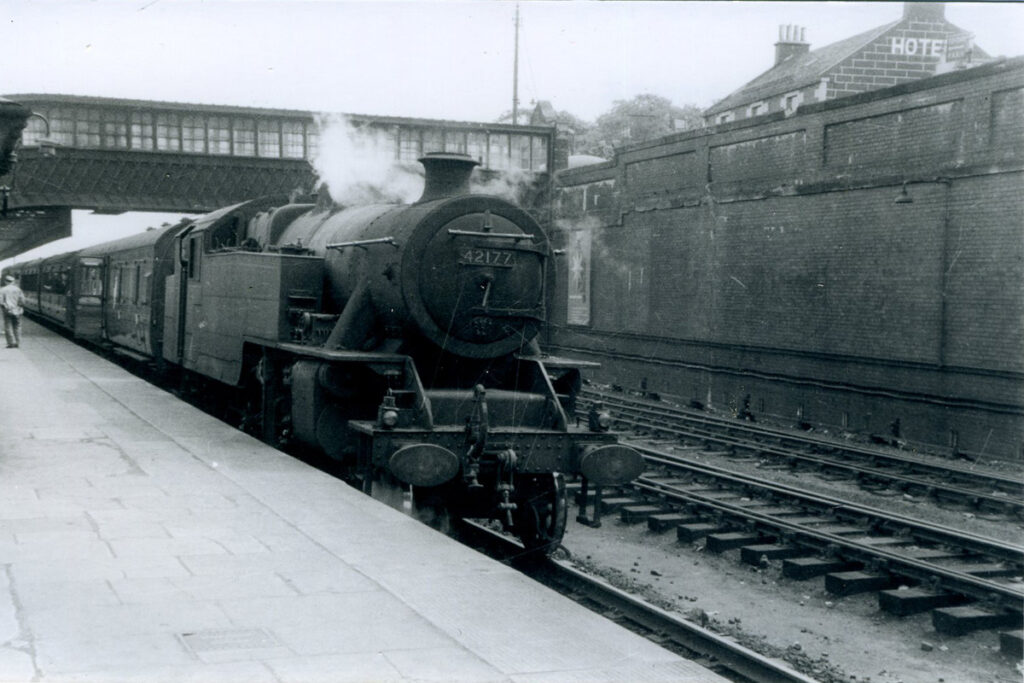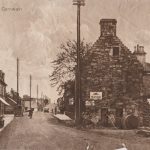Stories from a Railway Tearoom
The Caledonian Railway was opened in 1848, linking Carlisle, and the main line from London, with Glasgow and Edinburgh. The routes to the two Scottish cities diverged at a site described at the time as an “unproductive barren heath” which soon became known as Carstairs Junction. The junction station was a bustling place. Trains from the south were split into portions for Edinburgh and for Glasgow, and in the early days all of the Caledonian’s trains between those cities were also routed by Carstairs. During a stop at Carstairs, coaches might be shunted, engines watered, and passengers given an opportunity to stretch their legs after long journeys in carriages without toilets. On the platform they might be greeted by Willie the news vendor, who developed a lucrative business by selling Scottish newspapers to those arriving from England, while relieving them of their well-read English newspapers – which he then sold to those boarding the next southbound train.
The first Carstairs Junction station was described as “an unhandsome shed”, with a refreshment room that did not have a drinks licence. This was a great disappointment to Caledonian Railway staff enjoying a grand Glasgow Fair excursion to Edinburgh in 1851. It was reported that “a perfect invasion was made on the teetotal refreshment room, where demands for spirits, porter or ale were all met with a negative to the infinite disgust of some parties. Amazing quantities of ginger-beer and lemonade were however accounted for”. The revellers then had great fun squirting each other with hose pipes on the station platform.
A large new station building, with an overall roof supported on a timber frame, was built in 1854. Over 500 feet long, it was described at time of opening as “magnificent” and “unrivalled in Scotland” but gained little favour. It was later joked that the smoke and smut of every train that had passed through it remained plastered to its rafters and roof boards. As the Caledonian Railway’s network extended, the station became ever busier, with passengers converging from Peebles and Biggar, from Dolphinton, and from Muirkirk, Douglas, and Lanark. This growth in railway traffic was mirrored by a growth in the village of Carstairs Junction, constructed by the company to house staff engaged in the operation of the railway and maintenance of its equipment. By 1863, when the company built a school for the village children, sixty dwellings for company staff had already been constructed. The railway company also owned the Carstairs Junction hotel, built in the 1850’s on a site directly across from the entrance to the station
With passengers often needing to wait a considerable time between connections, the refreshment room with its licensed bar was always a popular place. The railway company usually leased its refreshment rooms to local operators who were responsible for securing a licence for the sale of alcohol. The Lanarkshire licensing board were usually sympathetic in granting a drinks licence to the Carstairs Junction refreshment room, recognising that it was a station that travellers passed through, rather than one that served as a destination. The licence usually allowed opening one hour earlier, and closing one hour later, than other licensed premises. It was said that in practice, the bar would continue serving drinks until the last train had departed, no matter how long it might have been delayed.
Local man Alexander Dobie secured the lease of the Carstairs Junction refreshment rooms in 1868 and continued to operate them for most of the period until his death in 1898. He seems to have been a public-spirited individual, providing silver trophies for the local quoiting club, and sponsoring community events.

Running a refreshment room was not without its dramas. In 1872 three railway brakemen were jailed for theft by housebreaking after a succession of raids on the storeroom of the refreshment room. The miscreants had forced their way into the roof space, cut a small hole in the ceiling of the store, and lowered a rope ladder. On various occasions small boys – employed by the railway company as wagon-greasers – were enticed to climb down the ladder and then hand up bottles of liquor to the thirsty brakesmen.
It is perhaps as a consequence of the drinking habits of some railway staff that the brave decision was reached the following year to stop serving alcohol, despite the considerable drop in income. The move did not go down well with some passengers. One irate traveller wrote to the newspapers complaining that “at a station where the patience of people is tried to the uttermost in the matter of being kept waiting, the least the company can do is to see that proper refreshments can be supplied to those who desire to have them”
After a period of two years the directors of the railway company decided to discontinue this teetotal experiment.
The refreshment room became the source of further controversy in November 1875, perhaps coinciding with a break in Alexander Dobie’s lease. First came a letter to the editor complaining about prices:
“I had nearly two hours to wait at Carstairs Junction. It was a very cold day and as there was no fire in the waiting room, I was tempted into the refreshment rooms. As an excuse for using the fire, I ordered a cup of coffee, and the girl in attendance told me that anything I wanted to eat I would find on the table. I had in all two small cups of coffee, one slice of plain bread and one slice of bacon, certainly not an ounce; and for this – a twopenny sandwich and two cups of coffee – I was charged three shillings ! In charge of my remark about extortion the girl rejoined that she “didna’ mak the prices”.
A written complaint to the proprietor received no answer.
Later that month another correspondent made the more serious complaint:
“On entering the refreshment room, and to my astonishment, I found several of the railway servants there getting refreshments. Now it is entirely opposed to all regulations…….. to enter refreshment rooms for purpose of obtaining liquor… and very often some of them seem not quite fit for duty” “A few days ago, while waiting as usual on my train, I observed one of the porters running along the platform and heard him shouting at the pitch of his voice, “take seats for Wallace of the Cross”, but I have looked in vain to find such a station in the company’s time tables, I believe however, the fellow was stupidly drunk”
A response was printed later that week, (perhaps from a serving railwayman), rebutting many of the claims, but admitting that he had observed railway servants being served drinks, but had been told that all were off duty.
Things seemed to settle down once Dobie again took charge, although the refreshment room continued to have the reputation as a haunt for those with “rubefacient predilections.” This expression was used in a rather snooty letter of complaint published in 1886 from a passenger with a through ticket who had been prevented from leaving the station to take lunch at the Carstairs Junction Hotel. Adopting a rather superior tone he inferred the station refreshment room might be a boon to red-nosed travellers fond of drink, but company rules failed to serve those who appreciated the higher culinary arts offered at the hotel.


The dingy and increasingly unsound old train-shed at Carstairs Junction was finally demolished in 1913 and replaced by a more airy arrangement of canopied platforms. The refreshment room closed in advance of this work, having not served alcohol since 1908, The increasing use of corridor coaches and dining cars had begun to render station facilities less necessary than was once the case. The proprietor of the Carstairs Junction Hotel took this opportunity to remodel his premises, turning their existing bar into a tearoom and setting up a new public bar on the site of the former hotel stables. In evidence to the licensing committee he explained that “in the afternoons and especially on Saturdays, a great many ladies came up for tea.”
This however was not the end of licensed refreshments at Carstairs Junction station. In 1934 the LMS (successor to the Caledonian Railway) applied to modify the station refreshment rooms (which were operated by their own hotel department) to allow the sale of alcohol. This was narrowly rejected by the licensing board; the police having advised that, “with 500 men employed by the railway at Carstairs, it would not be right to put temptation in their way”. In 1954 the nationalised British Railways were successful in obtaining a drinks licence for the refreshment rooms, arguing that it would be the only licensed refreshment room between Carlisle and Glasgow. Objections from the Carstairs Junction Hotel were disregarded.
The tearoom continued in operation until relatively recent times, and perhaps some readers may have their own recollections of the culinary and liquid delights that were served?
Sadly, all of the elegant range of Caledonian Railway station buildings were demolished in 2000, to be replaced by a simple shelter even more rudimentary than the wooden huts built when the line was first opened. On a cold winter’s day the scene brings to mind the words of the Edinburgh Evening News sports reporter, describing his journey to an England v. Scotland football match in 1908:
“Carstairs on a wintry morning, at the tail-end of a sleepless night, with an icy wind blowing ten to the dozen through the dreary length of the most sepulchral railway station in the South of Scotland is the epitome of cheerlessness.”




A Fairburn tank on a local service, probably in the early 60’s. Images taken in December 2024 showing the former Carstairs Junction Hotel; now “station apartments”, the original footbridge awaiting removal following installation of a new accessible entrance, and a local train waiting on the platform with the former hotel in the background.
Robin Chesters 19th December 2024
Unless otherwise stated, all text, images, and other media content are protected under copyright. If you wish to share any content featured on Clydesdale's Heritage, please get in touch to request permission.




